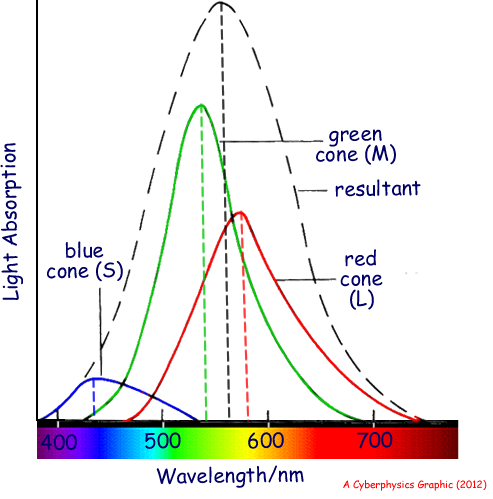Image formation - lighting effects: colour The colour that we percieve light as being depends on the stimulation of our bio-sensors. There are three types of colour detector in the eye called 'cones'. Each type of cone has a range of frequencies that it can detect, and the strength of the signal that it sends to the brain depends on how well the cone absorbs that colour and the 'brightness' of the illumination. If you look at the graph below you will see that for each wavelength of light in the visible part of the spectrum there is a different response from each of the cones. For example light of a wavelength of 500 nm will stimulate each of the cones - the green response being dominant. The response to a colour can be mimicked by a computer monitor. It has red, blue and green pixels. These can be 'lit' to different intensities within a region of the screen and produce the desired response from the eye. Computer coding for the colours have codes that indicate how bright the red-green-blue pixels should be. If they are to be 'off' then the code is zero (000) in HEX 00 - if they are to be fully on the code is 255 in HEX that is FF Therefore red is #FF0000; green is #00FF00 and blue is #0000FF Art and design packages allow you to alter the code for each of the colour part to obtain the colour you want. You make each part of the 'canvas' appear the colour that it does in reality. Your image then fools the eye that you picture matches 'reality' Colour in low light intensity environments The photons of light absorbed by the cones cause light-sensitive chemicals in the those cells to decompose and this stimulates electrical impulses in the associated nerve fibres leading to the brain. The size of the voltage produced indicates the intensity of light falling on them (the number of photos per second). If the light intensity is to low then colour cones will not 'fire' and vision is only in monochrome - from the 'rods' alone. A computer program needs to emulate the way that vision changes in low light intensity environments if it wants its visuals to look realistic. |
|

Custom Search



